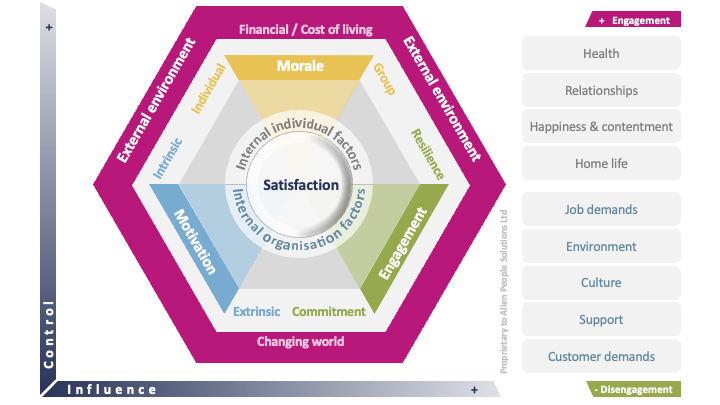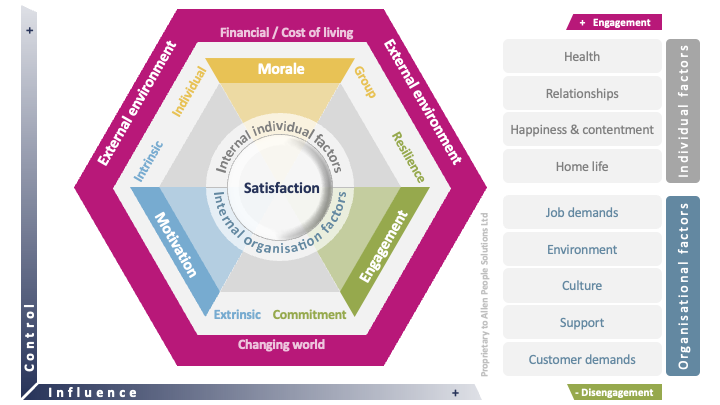
We all know that employee satisfaction has a massive influence on the success of any business and defines a worker’s perception of their job as a whole. It is widely understood that higher levels of employee satisfaction help predict a vast range of positive outcomes. These include, lower employee turnover, better customer experience, higher levels of workplace performance and productivity and employee wellbeing.
However, when we try to positively impact employee satisfaction, sometimes we can tend to take a sporadic approach, trying to fix a couple of things that we think might be the problem rather than taking a whole system approach.
Recently, we got to thinking more deeply about the complexities and inter relationship between engagement, morale, and motivation on employee satisfaction. The overall picture was complicated and inter-related. So much so, that we decided to develop our own model to help explain this as part of a recent client workshop.
By understanding the system, you may have a higher chance of effecting the right change, in the right place, at the right time to maximise return.
The model is based on three elements, three levels, multiple factors and two levers.

Engagement, Morale and Motivation all influence and contribute to an employee’s feeling of satisfaction with their job and employer.
The relationship between these factors is highly complex and often improving on one factor will begin to have a knock-on effect on the rest (either positively or negatively).
Using our model helps you look at the bigger picture and start to take a more integrated approach.
Engagement
The level of involvement and enthusiasm an employee demonstrates in their responsibilities and tasks.
It can be measured by both an employee’s resilience and commitment to work.
Resilience
Relates to employee’s ability to handle workloads including work quantity.
Commitment
Relates to the dedication, pride and care for their work including work quality.
Morale
How content people feel at a given moment towards work.
Morale can shift quickly from moment to moment given the many different events that take place in each day.
Morale can be measured either individually or as a Group.
Individual morale
Relates to individual attitude towards both their own work and the organisation they are working for.
Group morale
Relates to a collective attitude of the group as a whole towards collectively working together to accomplish the overarching goals.
Motivation
Links to the rewards an employee feels they receive, which in turn drives work efforts.
Motivation can be divided into intrinsic and extrinsic motivation.
Extrinsic motivation
Refers to the rewards employees receive from their organisation such as financial incentives, good working conditions.
Intrinsic motivation
Refers to their internal reward system such as a sense of having meaningful, challenging and fulfilling work, with a feeling of personal autonomy, as well as the engagement of critical thinking.
These three elements often overlap and influence each other and do not operate in isolation, in either having a positive impact on our engagement or a negative one, resulting in disengagement either as an individual or as a group over time.
For example, low individual morale can have a negative impact on commitment to their work or if left unchecked, it can start to have a detrimental effect on the group morale within the team or workplace as a whole.
Individual Factors
How we all feel as individuals at any one time is affected by a number of factors. These internal individual factors include our health, relationships, home life, and how happy and content we feel about life overall. All of these interact and impact on our feelings of morale, engagement, motivation and overall satisfaction.
Organisational Factors
The internal organisational factors also play an important role in terms of perceptions of the support available, job and customer demands, the overall culture and work environment.
External Environmental Factors
The external environmental factors add yet a further layer of complexity. For example, living in a complex and changing world (VUCA), the impact of cost of living and financial matters, all affect how we feel about life and work.
These factors, all act as levers that you have some influence and/or control over to bring about positive change.

The concept of the Circles of Influence, developed by Stephen Covey, relates to the extent to which we can exert Control or Influence in any given circumstance.
Control is the extent to which people, teams or the organisation can control what is happening.
Influence relates to what extent a person, teams or organisation can influence the response to that situation or circumstance.
A practical example of this was COVID. None of us had any control over this, and the vast majority of us had no control over the restrictions. However, we all, to varying degrees, had some level of influence in relation to how the organisation, teams and ourselves responded to this.
If we have limited control and influence, then moving into acceptance is important.
By understanding what we can control or influence and what we can’t, individually and/or as a group, we can start to take a systems approach and use the levers we have at our disposal to dial up the things where we can effect positive change and to compensate against those we can’t.
Sometimes, we can all be too quick to move into solutions before we properly understand the issue or problem we are trying to positively effect.
Given the complexities and multiple influences, between morale, motivation, and engagement on employee satisfaction, it can be helpful to take a step back to look at the bigger picture and take a whole system approach.
Map out what you have in place across each of the elements.
Think about and map what process, systems approaches and interventions you currently have in place across each of the three elements: morale, motivation and engagement.
For example, for motivation this could include having more formalised systems such as Performance Reviews and Development Plans and/or more informal regular checks-ins and feedback, or recognition systems.
For morale, this could include having clear organisational values, and aligned strategy with individual line of sight in terms of how they contribute to success.
For engagement, this could include work planning systems that are available, wellbeing support, project management or time management training.
Start to understand the strengths and any areas of focus to identify the gaps.
Consider the whole person to explore and identify the reasons why employees might feel satisfied or dissatisfied. Get to know your people, inside and outside of work, what makes them tick (as this is different for everyone).
For example, if morale and motivation are low, it could be because their values are not aligned with that of the organisation, or perhaps they are not feeling properly recognised for their efforts?
What is going on for them as an individual in work and life? This could be about health, relationships, home life or general contentment and happiness. What actions can they take and how can they best be supported?
Think about organising focus groups and/or an employee survey to find out what is working well and any areas for focus. By focusing on what you can control and/or influence, you can prioritise positive individual and collective actions to be taken.
If there are factors negatively affecting their engagement, motivation, or morale levels, seek to understand what action they can personally take and how the organisation can support this.
Determine the actions you can take by considering where you have influence or control to effect positive change.
Use the two levers (control and influence) to design integrated interventions and help people (employees and managers) understand the importance of their ‘circle of influence’.
By understanding what matters most to your team and understanding what levers you have influence and/or control over, you can start to design and implement positive changes for the better.
If control and influence are low, helping people work through to acceptance can be helpful. If it is higher, then finding the right levers to apply can help you work towards making positive changes.
For example, if employees feel the nature of the work is reactive, this may be true and a reflection of the actual nature of the work and organisation. That is; you have limited control over this. Accepting the extent to which this is true, can help move into problem solving.
You could start to explore ways they could have more influence over how they organise their day or prioritise their work or cope with changing demands.
If their job is highly repetitive, think about the job demands and opportunity to include tasks which allow the employee a higher level of autonomy over their work output or by introducing a level of job or task variety.
By understanding that some people feel intrinsically motivated, and others may be more motivated by external rewards and recognition, you can design the system to suit both.
Extrinsic motivation is about feeling recognised by the quality of their work output or by having challenging and inherently fulfilling work to perform. Knowing who is extrinsically motivated you can develop a talent plan to help ensure they have the right level of challenge and support.
Intrinsic motivation includes the need to receive regular positive feedback and reinforcement that they are doing a good job, as well as other factors. These individuals need more regular feedback to stay on track.
We all know that the behaviour of an actively disengaged employee is highly contagious and can have a massive impact on the morale and motivation of others. So, make sure you also have the difficult conversations in an open and supportive way.
Implement the actions, monitor, and measure the impact to enable continuous improvement.
Join our newsletter
Sign up to keep up to date with exclusive offers, updates and more.
UK & NI:
ROI:
Email: